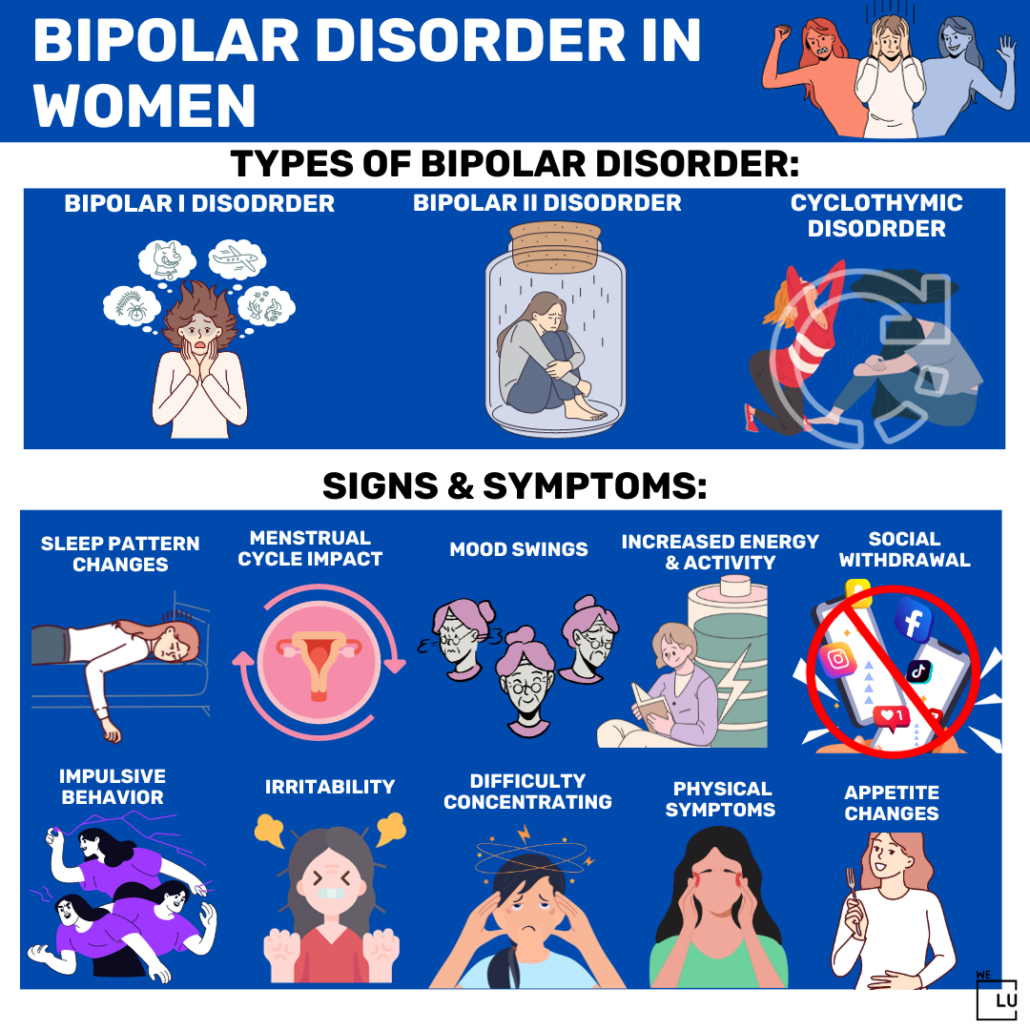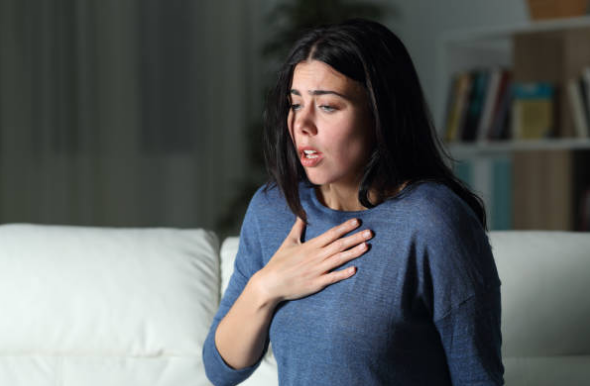Elevated Risk of Depression in Females
Bipolar II disorder, often associated with depression and hypomania, is more prevalent in females compared to bipolar I disorder. Females with bipolar disorder have double the likelihood of experiencing depression as males and are more prone to experiencing psychosis alongside depression. Owing to the predominance of depressive symptoms, females with bipolar disorder may frequently receive a misdiagnosis of depression.
Distinctive Symptom Patterns
Females with bipolar disorder exhibit a higher propensity for experiencing mixed episodes involving both elevated and depressive symptoms concurrently. Rapid cycling, where mood shifts occur swiftly, is also more common among females, with almost 30% of females experiencing rapid cycling compared to just over 16% of males. According to the DSM-5-TR, females with bipolar II disorder are more inclined to alternate between episodes rapidly.
Seasonal Impact
The same review from 2015 suggests that females with bipolar disorder tend to require hospital treatment more often in the spring and fall, unlike males whose symptoms peak in the spring. Females may also demonstrate a heightened risk of depressive symptoms during the fall and winter.
Associations with Other Conditions
Females with bipolar disorder may have an increased genetic risk of alcohol use disorder (AUD) and a higher prevalence of eating disorders, as suggested by studies in 2012 and 2010, respectively. Other health conditions and factors more frequently linked to bipolar disorder in females include borderline personality disorder (BPD), impulse control disorder, obesity, migraines, thyroid disease, and a history of sexual and physical abuse.
Risk of Suicide in Women with Bipolar Disorder
A 2015 review underscores that females with bipolar disorder are two to three times more likely to attempt suicide than males. A 2014 study examining suicide risk in both genders found that predictors of suicide risk in females included a history of numerous mixed episodes, an earlier onset of psychiatric symptoms, co-occurring personality disorders, and social difficulties in close relationships, such as family ties. In males, substance use was a significant predictor of suicide attempts.
First-class Facilities & Amenities
World-class High-Quality Mental Health Services & Behavioral Health Substance Abuse Treatment
Rehab Centers TourRenowned Mental Health Centers. Serene Private Facilities. Inpatient Rehab Programs Vary.
Mental Health Helpline (855) 940-6125Proven recovery success experience, backed by a Team w/ History of:
15+
Years of Unified Experience
100s
5-Star Reviews Across Our Centers
10K
Recovery Successes
- Comprehensive Dual-Diagnosis Treatment
- Complimentary Family & Alumni Programs
- Coaching, Recovery & Development Events
- Comfortable Onsite Medical Detox Center
Bipolar Symptoms in Women with Menstruation, Pregnancy, and Menopause
There are a lot of different ways that menstruation, pregnancy, menopause, and bipolar illness are all connected. These stages of life and changes in hormones can have a big effect on the course of bipolar disorder, changing both how often and how badly mood episodes happen. Here is a summary of how each stage is linked to bipolar disorder:
Menstruation
Getting worse before your period: Many women with bipolar disorder report an exacerbation of symptoms during their premenstrual phase, commonly known as premenstrual syndrome (PMS). Changes in hormones during this time can cause mood swings, which could lead to more frequent and serious episodes.
Changes in your hormones: The changes in hormones that happen during a woman’s period can make it harder for people with bipolar disorder to control their mood. Not all women have major mood changes, but women who have bipolar illness may be more likely to undergo these changes.

Being pregnant
Mixed Findings: Pregnancy’s impact on bipolar disorder is complex and varies from person to person. Some women’s moods stay stable while pregnant, while others may have mood swings. Pregnant women with bipolar disorder need to work closely with their doctors to control their condition and medications.
Medication Considerations: A lot of the medicines used to treat bipolar disorder could be harmful to a pregnant woman. Because of this, women may need to change their treatment plans while being watched by a doctor.
Menopause
Hormone Changes: Mood control can be affected by the changes in hormones during menopause, especially the drop in estrogen. During this time, some women with bipolar illness say their moods become more unstable.
Treatment Considerations: Managing bipolar symptoms during menopause might mean changing drugs or looking into new treatments. Hormonal changes can make old treatments less effective and more ineffective.
World-class, Accredited, 5-Star Reviewed, Effective Mental Health Dual Diagnosis Programs. Complete Integrated Inpatient Rehab with Free Post Discharge Therapy Planning.
CALL (855) 940-6125End the Emotional Pain Rollercoaster. Gain Stability & Happiness Through Recovery Treatment. Start Mental Health Counseling Today. Get Free No-obligation Guidance by Behaviroal Health Specialists Who Understand Mental Health Recovery.
Treating Bipolar Symptoms In Women
Treating bipolar symptoms in women typically involves a combination of medical interventions, psychotherapy, lifestyle changes, and a strong support system. Each treatment plan should be tailored to the individual’s specific needs and symptom severity. Here are some common approaches used to treat bipolar symptoms in women:
- Medication: Mood-stabilizing medications are often prescribed to manage bipolar symptoms. These may include mood stabilizers like lithium, anticonvulsants, and atypical antipsychotics. Medications help stabilize mood, reduce the frequency and intensity of episodes, and prevent relapses.
- Psychotherapy (Talk Therapy): Psychotherapy is an essential component of bipolar disorder treatment. Cognitive-behavioral therapy (CBT), dialectical behavior therapy (DBT), and interpersonal therapy are effective in helping individuals manage mood swings, develop coping strategies, and improve communication and interpersonal relationships.
- Family Therapy: Including family members in therapy sessions can help create a supportive and understanding environment for the woman with bipolar disorder. Family therapy can improve communication, educate family members about the condition, and enhance coping strategies for all involved.

Experience Transformative Recovery at the We Level Up Treatment Center.
See our authentic success stories. Get inspired. Get the help you deserve.



Start a New Life
Begin with a free call to a behavioral health treatment advisor. Learn more about our dual-diagnosis programs. The We Level Up treatment center network delivers recovery programs that vary by each treatment facility. Call to learn more.
- Personalized Care
- Caring Accountable Staff
- World-class Amenities
- Licensed & Accredited
- Renowned w/ 5-Star Reviews
We’ll Call You
Popular FAQs about Bipolar Symptoms In Women
-
What are the signs of bipolar in a woman?
Signs of bipolar disorder in a woman may include noticeable mood swings, impulsive behavior, changes in energy levels, difficulty concentrating, and episodes of elevated mood (mania) followed by deep sadness (depression).
-
What are common bipolar symptoms women?
Common bipolar symptoms in women include mood swings, impulsivity, changes in energy levels, sleep disturbances, difficulty concentrating, and episodes of mania and depression.
8 Steps & Tips for Maintaining Your Mental Wellbeing Informative Video
Video Script
We at We Level Up FL are dedicated to personalized mental health services tailored to each person’s unique needs. Our experienced team collaborates closely with clients to create therapy programs that address their challenges and align with their goals. With empathy and support, we empower individuals to take an active role in their mental health journey by providing tools and strategies. We encourage exploration, self-discovery, and growth in a safe and nurturing environment. We understand that everyone is different, so we listen attentively and develop customized therapy plans based on individual concerns, strengths, and aspirations.
Search Drug & Alcohol Rehab / Detox & Mental Health Bipolar Symptoms In Women Topics & Resources
Sources
- Bipolar disorder. (2023).
https://www.nimh.nih.gov/health/topics/bipolar-disorder/ - Azorin J-M, et al. (2013). Risks associated with gender differences in bipolar I disorder.
http://www.jad-journal.com/article/S0165-0327(13)00665-4/abstract - Diflorio A, et al. (2010). Is sex important? Gender differences in bipolar disorder.
https://www.tandfonline.com/doi/full/10.3109/09540261.2010.514601 - Farren CK, et al. (2012). Bipolar disorder and alcohol use disorder: A review.
https://www.ncbi.nlm.nih.gov/pmc/articles/PMC3730445/ - Bipolar disorder. (2021).
https://www.womenshealth.gov/mental-health/mental-health-conditions/bipolar-disorder-manic-depressive-illness - McElroy SL, et al. (2010). Prevalence and correlates of eating disorders in 875 patients with bipolar disorder.
https://lindnercenterofhope.org/wp-content/uploads/2014/06/2010-J-Aff-Disorders-Prevalence-and-correlates-of-eating-disorders-with-bipolar-disorder.pdf - Karanti A, et al. (2015). Gender differences in the treatment of patients with bipolar disorder: A study of 7354 patients.
https://www.sciencedirect.com/science/article/abs/pii/S0165032714007824 - Leiknes KA, et al. (2015). Electroconvulsive therapy during pregnancy: A systematic review of case studies.
https://www.ncbi.nlm.nih.gov/pmc/articles/PMC4305619/ - Parial S. (2015). Bipolar disorder in women.
https://www.ncbi.nlm.nih.gov/pmc/articles/PMC4539870/ - Munk-Olsen T, et al. (2006). New parents and mental disorders: A population-based register study.
https://jamanetwork.com/journals/jama/fullarticle/204395 - Nitzburg GC, et al. (2017). Coping strategies and real-world functioning in bipolar disorder.
https://www.ncbi.nlm.nih.gov/pmc/articles/PMC4859149/